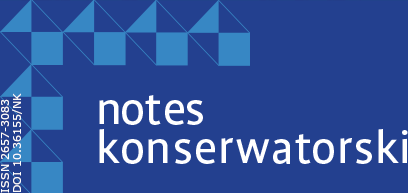
STRONA REDAKCYJNA, s. 1–12 / CREDITS, p. 1–12
POLITYKA OCHRONY I KONSERWACJI ZBIORÓW / PRESERVATION AND CONSERVATION POLICY
Narodowy Zasób Biblioteczny w Wojewódzkiej Bibliotece Publicznej im. Witolda Gombrowicza w Kielcach, s. 15–25 / National Library Resource in the Witold Gombrowicz Voivodeship Public Library in Kielce, p. 15–25
By the regulation of September 16th, 2016, the Minister of Culture and National Heritage of Poland included the collection of books from the Deskur family library in Sancygniów in the Świętokrzyskie Voivodeship into the National Library Resource. In the collection there are 2,677 volumes, including 314 early printed books – they used to be part of the Sancygniów collection, which numbered about 6,000 volumes. In 2009, the collection became the property of the Voivodeship Public Library in Kielce following the agreement negotiated with the heirs of Andrzej Deskur, the late owner of the library.
The text describes the collection, as well as provides information on the provenance of books and on the history of the creation of the library in the palace in Sancygniów. It also contains information about Andrzej Deskur, collector, creator of the library, and enthusiast of Polish literary tradition, who spent part of his extraordinary life in exile in Siberia. The Witold Gombrowicz Voivodeship Public Library in Kielce not only acquired the rights to the collection, but also took responsibility for its preservation. The text also includes a short description of the conditions and procedures that assure good preservation of the Deskur library.
FIZYKA, CHEMIA I MIKROBIOLOGIA W OCHRONIE I KONSERWACJI ZBIORÓW / PHYSICS, CHEMISTRY AND MICROBIOLOGY IN PRESERVATION AND CONSERVATION
Fizykochemiczne badania tybetańskiej kolekcji manuskryptów Drangsong z Mustangu w Nepalu, s. 29–51 / A Physicochemical Analysis of the Tibetan Drangsong Manuscript Collection from Mustang, Nepal, 29–51
This article presents the results of physico-chemical examination of the Drangsong Royal Manuscript Collection carried out within the project “Protecting the Kingdom with Tibetan Manuscripts: Codicological and Historical Analyses of the Royal Drangsong Collection From Mustang, Nepal". Manuscripts originating from the Bön Tibetan religious tradition have been carefully studied. The reflectance Transformation Imaging (RTI) method was used, which allowed for preparing very detailed photographic documentation, and facilitated the collection of data on the methods of making the paper and on its current state of preservation. X-ray fluorescence spectrometry (XRF) allowed for the determination of the major elemental composition of the paper. Based on the results obtained, it was possible to conclude that the manuscripts were characterized by a similar, high content of calcium, but different contents of other elements (Fe, Cu, Sr, Si, Ti, P, K). Further spectral data analysis confirmed the presence of aluminosilicates in the structure of the paper, and the analysis of strontium content allowed for the identification of two groups of the objects in question. The probable source of origin and the nature of the arsenic compound in the sample with a significant amount of this element were explained. Analysis of the fibrous composition of the paper identified the Daphne species as the its main component. In some samples, Stellera species fibers were also found. The above analyzes are an important step in creating a reference base for further physico-chemical research on paper from the area of Tibet.
A Physicochemical Analysis of the Tibetan Drangsong Manuscript Collection from Mustang, Nepal, p. 53–76
This article presents the results of physico-chemical examination of the Drangsong Royal Manuscript Collection carried out within the project “Protecting the Kingdom with Tibetan Manuscripts: Codicological and Historical Analyses of the Royal Drangsong Collection From Mustang, Nepal". Manuscripts originating from the Bön Tibetan religious tradition have been carefully studied. The reflectance Transformation Imaging (RTI) method was used, which allowed for preparing very detailed photographic documentation, and facilitated the collection of data on the methods of making the paper and on its current state of preservation. X-ray fluorescence spectrometry (XRF) allowed for the determination of the major elemental composition of the paper. Based on the results obtained, it was possible to conclude that the manuscripts were characterized by a similar, high content of calcium, but different contents of other elements (Fe, Cu, Sr, Si, Ti, P, K). Further spectral data analysis confirmed the presence of aluminosilicates in the structure of the paper, and the analysis of strontium content allowed for the identification of two groups of the objects in question. The probable source of origin and the nature of the arsenic compound in the sample with a significant amount of this element were explained. Analysis of the fibrous composition of the paper identified the Daphne species as the its main component. In some samples, Stellera species fibers were also found. The above analyzes are an important step in creating a reference base for further physico-chemical research on paper from the area of Tibet.
Szczegółowe badanie składu pierwiastkowego wskaźników Neevela: nowa propozycja wzbogacenia diagnostyki stanu rękopisów archiwalnych, s. 77–103 / Detailed study of the elemental composition of Neevel indices: a new proposal to enrich the determination of the condition of archival manuscripts, p. 77–103
In 2005, J.G. Neevel, Dutch chemist, proposed a new way to determine the condition of manuscripts based on the detection of excess iron ions in the ink. The concept of this method was based on the ability to detect only the free ions the can accelerate ink corrosion. The method proposed by Neevel uses a colour reaction occurring in paper indicators soaked with bathophenanthroline. The presence of free iron ions with an oxidation number of 2 (Fe2+) leads to the appearance of characteristic pink colouration, which bings clear visual information to the conservators about possible threats to the durability of the manuscripts. Until now, the lack of color change in the indicator has been interpreted as a symptom of the long-term stability of the object.
However, over the last several years, many different colour reactions of the indicators have been observed. In our work, we show that by examining the total elemental composition of the Neevel indices used, one can gain information about the chemical composition of inks, which helps the assessment of the condition of archival manuscripts. The advantage of the presented research concept is the complete avoidance of the need for mechanical sampling and transport of documents to the laboratory. A certain limitation to this approach may be the need to use an instrumental method, characterized by low detection limits and high sensitivity of multi-element measurements. In our work, we describe the application of laser ablation inductively coupled plasma mass spectrometry (LA-ICP-MS) method and laser micro-sampling. On selected examples, we show the possibilities of detecting if iron is accompanied with elements such as: copper, manganese, sulphur, zinc, lead, aluminium, as well as potassium, sodium and magnesium, and discussed the differences in their proportions in Neevel indicators.
HISTORIA, BADANIA I KONSERWACJA FOTOGRAFII / HISTORY, STUDIES AND CONSERVATION OF PHOTOGRAPHY
Konserwacja szklanych negatywów autorstwa Edwarda Janusza pochodzących z Galerii Fotografii Miasta Rzeszowa jako proces przygotowawczy do digitalizacji kolekcji, s. 107–122 / Conservation of Edward Janusz’s glass negatives from the Photo Gallery of the City of Rzeszów as a preparatory process for the digitization of the collection, p. 107–122
The main aim of the conservation work carried out in 2018 by Krzysztof Dudek, a certified conservator and restorer of works of art, was to protect the 1,050 glass negatives, created at the turn of the 19th and 20th centuries in Edward Janusz’s photographic studio in Rzeszów, from further destruction and to prevent destruction processes, as well as to restore their full aesthetic value (with as little interference as possible) while maintaining their historic character. By removing impurities and non-original elements from the surface of the negatives, the original content of the so-called photographic emulsion was uncovered. All the conservation works carried out were an introduction to the digitization of the collection of negatives kept in a specialized warehouse at the Photo Gallery of the City of Rzeszów.
Konserwacja i zabezpieczenie kolekcji autochromów autorstwa Jana Zdzisława Włodka, s. 123–142 / Conservation and preservation of the autochrome collection by Jan Zdzisław Włodek, p. 123–142
The article is devoted to the unique collection of photographs taken in autochrome technique by the Polish agronomist, legionary and diplomat, Jan Zdzisław Włodek. The text describes the process of conservation and preservation of the collection consisting of 251 objects. First, the history of creation and multilayer technological structure of autochromes is described. Next, the author presents the state of conservation of the collection and the most frequent damages visible on the objects. The conservation process is described from the stage of making conservation documentation, through the processes of mechanical and chemical cleaning, sealing the objects or making housings for a broken objects, to the protection with certified protective enclosure. The text is illustrated by photographs taken during the documentation and conservation work.
Z PRAKTYKI KONSERWATORA / FROM A CONSERVATOR’S PRACTICE
Acetyloceluloza – trudna spuścizna konserwatorska w świetle doświadczeń w konserwacji plakatów propagandowych z zasobu Archiwum Akt Nowych, s. 145–172 / Acetylcellulose: difficulties in the conservation of propaganda posters from the collection of the Central Archives of Modern Records, p. 145–172
The glue based on cellulose acetate (CA), or acetylcellulose, used from the beginning of the 1930s to the end of the 20th century in archives and libraries around the world, still poses a conservation problem. After World War II, the national archives in Poland, faced with the problem of the disastrous state of preservation of their collections, for the first time in 1960, decided to use this biostatic glue with the so-called cold lamination method. Unfortunately, as the time goes by and the physicochemical changes occur in the glue, it loses its properties and contributes to the deterioration of the condition of the paper substrate on which it is applied. The condition of the objects, in particular those made of short-grain and acidified paper, deteriorates significantly. The paper turns yellow, becomes weakened and increasingly susceptible to mechanical damage, and thus requires regular maintenance.
In 2020, the Conservation Department of the Central Archives of Modern Records undertook the conservation of 42 posters from the fonds of the Towarzystwo Straży Kresowej [Border Guard Society], most of which had once been preserved with cellulose acetate. The problem was not so much removing the old duplicate from the Japanese tissue, but extracting the glue that had penetrated deep into the structure of the paper. The basic solvent that was used was acetone, which was applied in various variants, also in warm form. After these treatments, the posters were successfully subjected to full conservation and placed in protective packaging.
Rękopis Theatrum virtutum… Tomasza Tretera w świetle zagadnień technologicznych, s. 173–188 / The manuscript of Theatrum virtutum… by Tomasz Treter: technological issues, p. 173–188
The collection of the National Library of Poland holds a manuscript by Tomasz Treter, containing drawings for a series of emblems dedicated to Bishop Stanislaus Hosius (Stanisław Hozjusz). In the literature to date, this collection of drawings has been discussed mainly in terms of iconography. The analysis of technological issues proposed by the author of the present article puts the discussed manuscript in a slightly different light. The examination of its aspects, such as the construction of the block of the book or the type of paper used to form the sections, allows to obtain information about the artist’s techiques, and the original function and form of the manuscript. The research methods included are based mainly on simple visual inspection of the elements of the volume’s structure. In the longer term, it may be interesting to analyze Trete’s drawings using multispectral photography.
KONFERENCJE, WARSZTATY, WYDARZENIA / CONFERENCES, WORKSHOPS, EVENTS
Kalendarium wydarzeń 2021, s. 191–203
Polemika, s. 205–207

